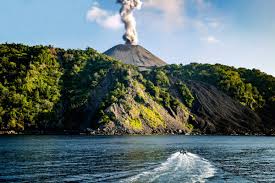Context: Recently collected samples from India’s only active mud volcano at Baratang in the Andaman and Nicobar Islands belong to the Oligocene age, which was around 23 million years ago, as per Geological Survey of India.
More on the News
- The lithoclasts ejected from the crater were found to be composed of sandstone and shale of the Mithakari Group, belonging to Oligocene geological period.
- An oily blackish sheen was also observed at a few vents as thin layers on the surface of the muddy material.
Characteristics of mud volcano
- Surface temperature: The surface temperature of the mud volcanoes ranged from 29.3 degrees C to 30.07 degrees C.
- pH Level: The pH level of the mud fluid is between 8.0 and 8.3, indicating a weakly alkaline nature.
- Area of eruption: The area of the eruption site has increased to about 500 sqm with a height of about 2 meters.
Oligocene Age
- The Oligocene epoch lasted from approximately 33.9 to 23 million years ago, following the Eocene and preceding the Miocene.
- This period is characterized by global cooling and the significant development of grasslands, which spurred the evolution of many modern mammals like early horses, elephants, and dogs.

